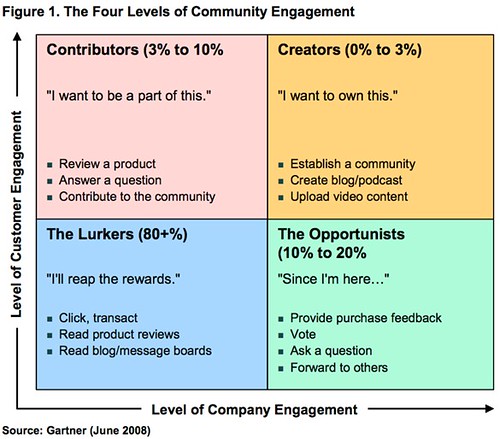
Above Image: Gartner’s Generation V Quadrant, found via Marketing Charts.
Gartner: Generation Virtual not defined by demographics
Gartner has recently published research on the topic of “Generation Virtual” (Generation V) which essentially define as two things: 1) This generation isn’t specified by demographics (age) but instead by technology usage. 2) There are four major behaviors
Gartner suggests that Generation V isn’t a demographic categorization, but instead behavioral:
“Unlike previous generations, Generation Virtual (also known as Generation V) is not defined by age – or gender, social demographic or geography – but is based on demonstrated achievement, accomplishments and an increasing preference for the use of digital media channels to discover information, build knowledge and share insights.”
This is an interesting notion, but I’d suggest that having a demographic overlay is actually very important. First of all, demographics are how brands develop personas of who they are trying to reach, bucketing all internet contributors into one classification may be too broad. Secondly, within Generation V, demographics influences the different tools they use. For example, youth may be more inclined to participate in Club Penguin, while an older professional may be more inclined to participate in Linkedin or Xing demographics do matter. We focus on Social Technographics, which is also behavioral yet closely tied to demographics (age, country, gender, etc).
Gartner: Four major behaviors with Generation Virtual
Secondly, Gartner focuses on four different behavior types: creators, contributors, opportunities, and lurkers:
“Gartner has identified four levels of engagement within Generation V, addressing both the extent to which customers will engage with other customers, as well as the level of engagement needed from businesses to enable the community. The four levels of engagement include: creators, contributors, opportunists, and lurkers.”
This is a helpful segmentation, it indicates that while Generation V composes of a movement of those participating, there are different levels to each behavior. One suggestion is to forgo the term “lurker” (reminiscent of someone standing in the shadows) and instead focus on “spectator”. We note that there are other behaviors beyond the four listed, such as creators, critics, collectors, joiners, spectators, and inactives. Furthermore we do not view these behaviors as mutually exclusive, a creator on one site could be inactive on another. They suggest only a limited number of activity per each behavior:
“Up to 3 percent of individuals will be creators, providing original content and can be advocates that promote your product and services. Between 3 percent and 10 percent of individuals will be contributors, essentially followers, who add to the conversation, but don’t initiate it. They can recommend products and services as customers move through a buying process, looking for purchasing advice. Between 10 percent and 20 percent of individuals will be opportunists, who can further contributions regarding purchasing decisions. Opportunists can “add value” to a conversation that’s taking place, while walking through a considered purchase. Approximately 80 percent of individuals will be lurkers (and all users start as such), essentially spectators, who reap the rewards of online community input, but only absorb what is being communicated. However, they can implicitly contribute and validate indirectly reporting the value from the rest of the community.”
I’ve not read the full report to get the context (but would like to) but his coverage seems to slant the CRM side. I believe it’s important to note that demographics indeed influence behaviors, see this technographic profile tool, and you’ll quickly notice different behaviors, with an increase in adoption from those younger –particularly see the US charts.
Gartner’s Analyst Adam Sarner does an excellent article featured in Forbes that lists more, it’s a good read with some very practical recommendations. I hope to meet Adam someday (see his Gartner profile), and discuss communities more in detail.
To Consider: Demographics do matter
In summary, while this breakdown of “Generation V’ is certainly telling of where things are headed, demographics are critical, as behaviors and where they participate will radically differ.
As an analyst at Forrester Research primarily covering social networks and communities for interactive marketers, it’s confirmation to hear of other analyst firms discussing my same coverage area. For some, it may seem counter-intuitive for me to discuss about another firm’s work, but it’s important to me that I provide helpful information to my network, regardless of source, and hopefully they’ll continue to trust me and come back to me –even when I send them away.
Update: There’s more conversation on Friendfeed. Carter Lusher (analyst watcher) is impressed we can have a civil discussion, why couldn’t we? Also, I’ve made some edits to this blog, post-publication around the area of indicating that our technographics is tied to both behavior and demographics, and discussing how our behaviors (creators, critics, etc) are not mutually exclusive to provide additional explanation.
Good discussion, Jeremiah.
Clearly, there is an important connection between behavior and “*”-ographics. For some purposes, it is better to begin with demographics and then move to understand behavior. For other purposes, it is worthwhile to begin with objective behavior and pull in demographics/psychographics/technographics as needed.
There is an analogy between my colleague’s Generation V concept and the use of personas in Web design projects. A persona is a collection of *-ographic attributes that is, at the end of the day, tied to objectively observable behavior — behavior that is hopefully consistent with desired user interaction scenarios that deliver ROI.
I think we all would agree that, regardless of how we begin the analysis, at some point it must encompass concrete scenarios that deliver business value — i.e., relevant behavior.